Customer Logins
Obtain the data you need to make the most informed decisions by accessing our extensive portfolio of information, analytics, and expertise. Sign in to the product or service center of your choice.
Customer Logins
ECONOMICS COMMENTARY
May 19, 2023
Malaysian economy shows sustained expansion in early 2023
The Malaysian economy grew at a pace of 5.6% year-on-year (y/y) in the first quarter of 2023, showing continued rapid expansion after annual economic growth of 8.7% in 2022. The buoyant pace of economic growth in 2022 was the fastest annual GDP growth rate since 2000.
The pace of expansion of the Malaysian economy is expected to moderate during 2023 due to a number of headwinds, including the impact of high base year effects and slowing merchandise export growth. However, an important positive factor is expected to be the continued gradual recovery of international tourism visits from Asia, the Middle East and Europe.
Malaysian economy maintains positive momentum in Q1 2023
The Malaysian economy grew at a pace of 5.6% y/y in the first quarter of 2023, after growing at 7.1% y/y in the fourth quarter of 2022. Measured on a quarter-on-quarter (q/q) basis, the Malaysian economy grew by 0.9% q/q in the first quarter of 2023, marking a sharp turnaround after contraction of 1.7% q/q in the fourth quarter of 2022.
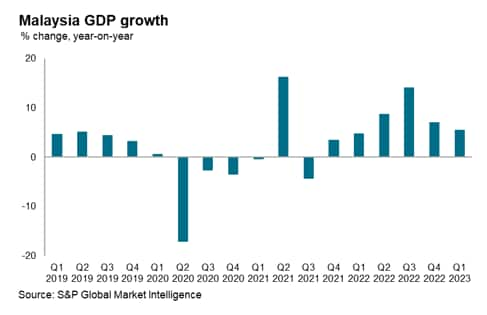
Helped by strong domestic demand, the Malaysian services sector continued to show rapid growth of 7.3% y/y in the first quarter of 2023, following growth of 9.1% y/y in the fourth quarter of 2022. The pace of expansion in the construction sector also remained strong, growing by 7.4% y/y in the first quarter of 2023, after rapid growth of 10.1% y/y in the fourth quarter of 2022. However, growth in the manufacturing sector has moderated in recent quarters, growing by 3.2% y/y in the first quarter of 2023, similar to the 3.9% y/y pace in the fourth quarter of 2022.
The seasonally adjusted S&P Global Malaysia Manufacturing Purchasing Managers' Index (PMI) was unchanged at 48.8 in April, signalling that business conditions remained challenging for firms. That said, the index was at its joint-highest level since September 2022, suggesting a tentative recovery in operating conditions in recent months.
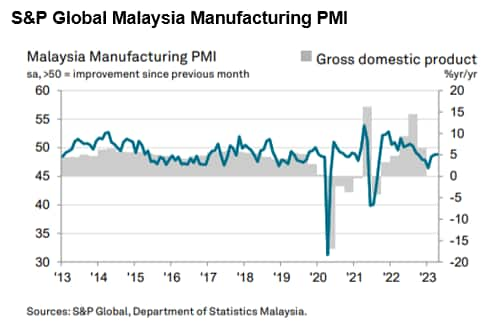
During 2022, an important positive factor for the Malaysian manufacturing sector was the strength of manufacturing exports. Overall, Malaysian merchandise exports has performed strongly during 2022, with exports rising by 25% y/y. Exports of manufactured goods rose by 22% y/y during 2022, boosted by exports of electrical and electronic products, which rose by 30%.
Rising world commodity prices also boosted commodities exports, with mining exports up by 68% y/y due to strong exports of oil and gas, while agricultural exports rose by 23%.
In 2023, the pace of export growth is expected to moderate, reflecting base year effects as well as the economic slowdown in key markets, notably the US and EU. Goods exports in the first quarter of 2023 rose by 2.8% y/y, with the pace of export growth moderating significantly compared with 2022.
As mainland China is Malaysia's largest export market, accounting for 15.5% of total exports, the continuing rebound in mainland China's economy during 2023 may help to mitigate the impact of softening merchandise exports to the US and EU.
However international tourism is expected to strengthen during 2023, as tourist arrivals from major tourism markets in ASEAN, Middle East and Europe continue to recover, while Chinese tourist arrivals gradually improve. Tourism Malaysia is targeting 16.1 million international visitor arrivals for 2023, a 60% increase compared with the estimated 10.1 million international visitor arrivals in 2022. This compares with the pre-pandemic level of 26.1 million international visitor arrivals in 2019. In 2019, total domestic and international tourism was estimated to have accounted for around 16% of gross value added in Malaysia's total GDP.
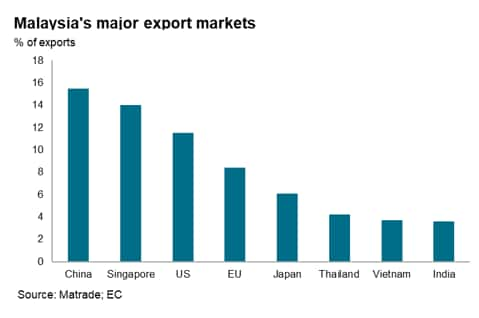
Inflation pressures have been gradually easing
Reduced demand for inputs helped lead to an improvement in vendor performance, with improved capacity at suppliers and a lack of port congestion also aiding a reduction in lead times. Suppliers' delivery times shortened for the fourth successive month and to one of the greatest extents in the past decade. There were further signs of raw material prices levelling off in April as input costs rose only slightly. The rate of inflation was broadly in line with the 34-month low posted in March.
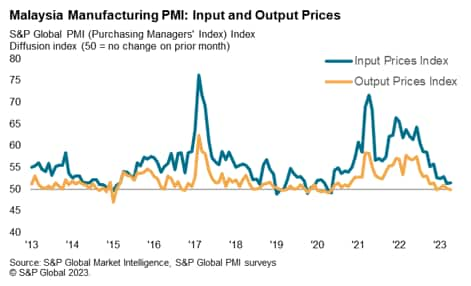
In Malaysia, CPI inflation pressures have begun to gradually moderate, easing to a pace of 3.4% in March 2023, compared with 4.5% y/y in September 2022.
During 2022, Malaysia's central bank, Bank Negara Malaysia (BNM), had reduced the degree of monetary accommodation in a series of tightening steps. The most recent monetary policy tightening was on 3rd May 2023, when the Monetary Policy Committee decided to increase the Overnight Policy Rate (OPR) by 25 basis points (bps) to 3.0 percent.
The MPC expects that both headline and core inflation will moderate over the course of 2023, averaging between 2.8% and 3.8%. However, core inflation will remain at elevated levels amid firm demand conditions. Existing price controls and fuel subsidies will continue to partly contain the extent of upward pressures to inflation.
Moderating global electronics demand adds to headwinds
The electrical and electronics (E&E) sector has been an important driver of Malaysia's manufacturing exports. Exports of E&E products, which accounted for 38% of merchandise exports, rose by 30% y/y in 2022. This rapid growth was driven by robust global demand for semiconductors, reflecting technological trends such as 5G rollout, cloud computing, and the Internet of Things. Exports of integrated circuits grew by 33% y/y in 2022, while exports of parts for integrated circuits rose by 120% y/y. The combined exports of integrated circuits and parts accounted for 58% of Malaysia's total exports of E&E products in 2022.
The global electronics manufacturing industry slowed in the second half of 2022 due to the weakening pace of economic growth in the US, EU and China.
Malaysian exports of electrical and electronic products fell by 4.4% year-on-year in March 2023.
Recent S&P Global survey data indicates that the global electronics manufacturing industry is facing headwinds from the weakening pace of global economic growth. The headline seasonally adjusted S&P Global Electronics PMI fell from 51.4 in February to 48.4 in March, weakening further in April to 48.2. This signalled renewed deterioration in operating conditions across the global electronics manufacturing sector as key consumer markets for electronics, notably the US and EU, remained weak.
Malaysian exports of electrical and electronic products fell by 4.4% year-on-year in March 2023. Malaysia's E&E industry is expected to face continuing soft economic conditions during 2023, compared with the very rapid pace of expansion in 2022. The latest data indicated a renewed contraction in the global electronics sector, reflecting further declines in new orders and output.
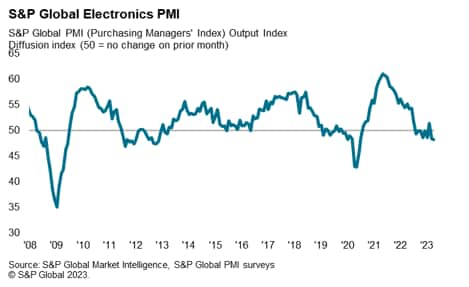
Demand conditions for the global electronics industry have remained weak during early 2023. Subdued client demand weighted on new business placed with electronics manufacturers, as new orders fell for the nineth time in the past ten months. Inflationary pressures and global economic uncertainty were often cited by panellists as factors dampening demand.
New orders in the Consumer Electronics segment fell at the fastest pace for six months, while there was a renewed decline in Industrials, the first since January. Computing saw a slower contraction while demand conditions for the Communications segment stabilized.
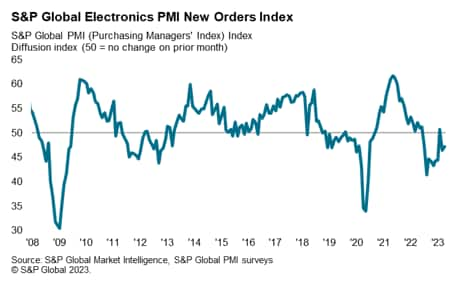
Economic outlook
The Malaysian economy rebounded strongly during 2022, with economic growth momentum boosted by the easing of COVID-19 restrictive measures as well as buoyant exports of electrical and electronic products, palm oil products as well as oil and gas exports.
In 2022, higher world oil and gas prices as a result of the Russia-Ukraine war boosted Malaysian energy exports and contributed to higher fiscal revenues. Malaysia also benefited from higher average palm oil prices, due to disruptions to world edible oil markets, including Ukrainian exports of sunflower oil.
During 2023, growth momentum is expected to moderate due to base year effects and the slowdown of merchandise exports. However, the reopening of international borders across the Asia-Pacific region, notably in mainland China, will help the continued gradual recovery of the international tourism industry, which was an important part of the Malaysian economy prior to the pandemic. This will help to mitigate the impact of slower growth for merchandise exports. Domestic demand is expected to be resilient in 2023, helped by the improvement in labour market conditions. Easing of restrictions on entry of migrant labor will also gradually help to support industry sectors that are reliant on foreign workers.
There are a number of downside risks to the near-term growth outlook, particularly due to the slowdown in world growth. Malaysia's export sector is vulnerable to protracted weak economic growth momentum in the US and EU, which together account for around one-fifth of total exports. However, the easing of COVID-19 restrictions in mainland China could help to boost Malaysian exports to this key market, which is Malaysia's largest export market and accounts for around 15% of total exports.
Despite the slowdown in global electronics orders in recent months, the medium-term economic prospects for Malaysia's electronics industry are favourable. The outlook for electronics demand is underpinned by major technological developments, including 5G rollout over the next five years, which will drive demand for 5G mobile phones.
Demand for industrial electronics is also expected to grow rapidly over the medium term, helped by Industry 4.0, as industrial automation and the Internet of Things boosts rapidly growth in demand for industrial electronics.
Malaysia's competitiveness as a global electronics hub has been highlighted by the decision of a number of electronics multinationals to invest in large-scale new projects. Intel is investing USD 7 billion in a new semiconductors packaging plant in Penang, which is estimated to be completed by 2024 and create thousands of new jobs in Malaysia. Infineon Technologies is constructing a new state-of-the-art wafer fab module in Kulim, with around Ringgit 8 billion of investment. The new module, which is expected to be completed in 2024, will add significant manufacturing capacity in power semiconductors.
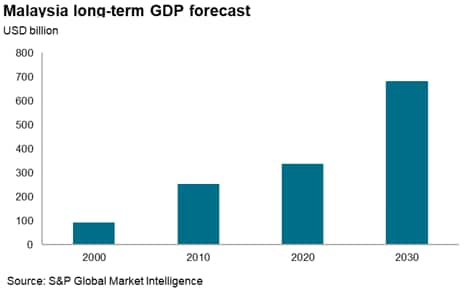
Overall, the medium to long-term growth outlook for Malaysia remains favourable, with total nominal GDP measured in USD terms forecast to rise from around USD 400 billion in 2022 to USD 680 billion by 2030 and USD 780 billion by 2032. Meanwhile per capita GDP is projected to rise from USD 12,000 in 2022 to USD 18,600 by 2030, which will help to drive the growth of the domestic consumer market.
Rajiv Biswas, Asia Pacific Chief Economist, S&P Global Market Intelligence
Rajiv.biswas@spglobal.com
© 2023, S&P Global Inc. All rights reserved. Reproduction in
whole or in part without permission is prohibited.
Purchasing Managers' Index™ (PMI®) data are compiled by S&P Global for more than 40 economies worldwide. The monthly data are derived from surveys of senior executives at private sector companies, and are available only via subscription. The PMI dataset features a headline number, which indicates the overall health of an economy, and sub-indices, which provide insights into other key economic drivers such as GDP, inflation, exports, capacity utilization, employment and inventories. The PMI data are used by financial and corporate professionals to better understand where economies and markets are headed, and to uncover opportunities.
This article was published by S&P Global Market Intelligence and not by S&P Global Ratings, which is a separately managed division of S&P Global.
{"items" : [
{"name":"share","enabled":true,"desc":"<strong>Share</strong>","mobdesc":"Share","options":[ {"name":"facebook","url":"https://www.facebook.com/sharer.php?u=http%3a%2f%2fwww.spglobal.com%2fmarketintelligence%2fen%2fmi%2fresearch-analysis%2fmalaysian-economy-shows-sustained-expansion-in-early-2023-may23.html","enabled":true},{"name":"twitter","url":"https://twitter.com/intent/tweet?url=http%3a%2f%2fwww.spglobal.com%2fmarketintelligence%2fen%2fmi%2fresearch-analysis%2fmalaysian-economy-shows-sustained-expansion-in-early-2023-may23.html&text=Malaysian+economy+shows+sustained+expansion+in+early+2023+%7c+S%26P+Global+","enabled":true},{"name":"linkedin","url":"https://www.linkedin.com/sharing/share-offsite/?url=http%3a%2f%2fwww.spglobal.com%2fmarketintelligence%2fen%2fmi%2fresearch-analysis%2fmalaysian-economy-shows-sustained-expansion-in-early-2023-may23.html","enabled":true},{"name":"email","url":"?subject=Malaysian economy shows sustained expansion in early 2023 | S&P Global &body=http%3a%2f%2fwww.spglobal.com%2fmarketintelligence%2fen%2fmi%2fresearch-analysis%2fmalaysian-economy-shows-sustained-expansion-in-early-2023-may23.html","enabled":true},{"name":"whatsapp","url":"https://api.whatsapp.com/send?text=Malaysian+economy+shows+sustained+expansion+in+early+2023+%7c+S%26P+Global+ http%3a%2f%2fwww.spglobal.com%2fmarketintelligence%2fen%2fmi%2fresearch-analysis%2fmalaysian-economy-shows-sustained-expansion-in-early-2023-may23.html","enabled":true}]}, {"name":"rtt","enabled":true,"mobdesc":"Top"}
]}




